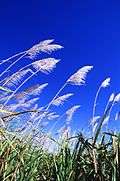Hemp

Hemp or industrial hemp (from Old English hænep),[1] typically found in the northern hemisphere, is a variety of the Cannabis sativa plant species that is grown specifically for the industrial uses of its derived products.[2] It is one of the fastest growing plants[3] and was one of the first plants to be spun into usable fiber 10,000 years ago.[4] It can be refined into a variety of commercial items including paper, textiles, clothing, biodegradable plastics, paint, insulation, biofuel, food, and animal feed.[5]
Although cannabis as a drug and industrial hemp are both members of the species Cannabis sativa and contain the psychoactive component tetrahydrocannabinol (THC), they are distinct strains with unique biochemical compositions and uses.[6] Hemp has lower concentrations of THC and higher concentrations of cannabidiol (CBD), which decreases or eliminates its psychoactive effects.[6] The legality of industrial hemp varies widely between countries. Some governments regulate the concentration of THC and permit hemp that's bred with an especially low THC content.[7][8]
Etymology
The etymology is uncertain but there appears to be no common Proto-indoeuropean source for the various forms of the word; the Greek term kánnabis is the oldest attested form, which may have been borrowed from an earlier Scythian or Thracian word.[9][10] Then it appears to have been borrowed into Latin, and separately into Slavic and from there into Baltic, Finnish, and Germanic languages.[11] Following Grimm's law, the "k" would have changed to "h" with the first Germanic sound shift,[9][12] after which it may have been adapted into the Old English form, hænep. However, this theory assumes that hemp was not widely spread among different societies until after it was already being used as a psychoactive drug, which Adams and Mallory (1997) believe to be unlikely based on archaeological evidence.[9] Barber (1991) however, argued that the spread of the name "kannabis" was due to its historically more recent drug use, starting from the south, around Iran, whereas non-THC varieties of hemp are older and prehistoric.[11] Another possible source of origin is Assyrian qunnabu, which was the name for a source of oil, fiber, and medicine in the 1st millennium BC.[11]
Cognates of hemp in other Germanic languages, include Dutch hennep, Danish and Norwegian, hamp; German, hanf; and Swedish, hampa.[9]
Uses

Hemp is used to make a variety of commercial and industrial products including rope, clothes, food, paper, textiles, plastics, insulation and biofuel.[5] The bast fibers can be used to make textiles that are 100% hemp, but they are commonly blended with other organic fibers such as flax, cotton or silk, to make woven fabrics for apparel and furnishings. The inner two fibers of the plant are more woody and typically have industrial applications, such as mulch, animal bedding and litter. When oxidized (commonly referred to as "drying"), hemp oil from the seeds becomes solid and can be used in the manufacture of oil-based paints, in creams as a moisturizing agent, for cooking, and in plastics. Hemp seeds have been used in bird feed mix as well.[13] A survey in 2003 showed that more than 95% of hemp seed sold in the European Union was used in animal and bird feed.[14]
Food

Hemp seeds can be eaten raw, ground into a meal, sprouted, or made into dried sprout powder. The leaves of the hemp plant can be consumed raw in salads. Hemp can also be made into a liquid and used for baking or for beverages such as hemp milk, hemp juice, and tea.[15] Hempseed oil is cold-pressed from the seed and is high in unsaturated fatty acids.[16] In 2011, the U.S. imported $11.5 million worth of hemp products, mostly driven by growth in demand for hemp seed and hemp oil for use as ingredients in foods such as granola.[17]
In the UK, the Department for Environment, Food and Rural Affairs (Defra) treats hemp as a purely non-food crop, but with proper licensing and proof of less than 0.2% THC concentration, hemp seeds can be imported for sowing or for sale as a food or food ingredient.[18] In the U.S., imported hemp can be used legally in food products and as of 2000, was typically sold in health food stores or through mail order.[16]
Nutrition
| Nutritional value per 100 g (3.5 oz) | |
|---|---|
| Energy | 2,451 kJ (586 kcal) |
|
4.67 g | |
| Sugars |
1.50 g 0.07 g |
| Dietary fiber | 4.0 g |
|
48.75 g | |
| Saturated | 4.600 g |
| Trans | 0 g |
| Monounsaturated | 5.400 g |
| Polyunsaturated |
38.100 g 9.301 g 28.698 g |
|
31.56 g | |
| Tryptophan | 0.369 g |
| Threonine | 1.269 g |
| Isoleucine | 1.286 g |
| Leucine | 2.163 g |
| Lysine | 1.276 g |
| Methionine | 0.933 g |
| Cystine | 0.672 g |
| Phenylalanine | 1.447 g |
| Tyrosine | 1.263 g |
| Valine | 1.777 g |
| Arginine | 4.550 g |
| Histidine | 0.969 g |
| Alanine | 1.528 g |
| Aspartic acid | 3.662 g |
| Glutamic acid | 6.269 g |
| Glycine | 1.611 g |
| Proline | 1.597 g |
| Serine | 1.713 g |
| Vitamins | |
| Vitamin A equiv. |
(0%) 1 μg (0%) 7 μg |
| Vitamin A | 11 IU |
| Thiamine (B1) |
(111%) 1.275 mg |
| Riboflavin (B2) |
(24%) 0.285 mg |
| Niacin (B3) |
(61%) 9.200 mg |
| Vitamin B6 |
(46%) 0.600 mg |
| Folate (B9) |
(28%) 110 μg |
| Vitamin B12 |
(0%) 0 μg |
| Vitamin C |
(1%) 0.5 mg |
| Vitamin E |
(5%) 0.80 mg |
| Minerals | |
| Calcium |
(7%) 70 mg |
| Iron |
(61%) 7.95 mg |
| Magnesium |
(197%) 700 mg |
| Manganese |
(362%) 7.600 mg |
| Phosphorus |
(236%) 1650 mg |
| Potassium |
(26%) 1200 mg |
| Sodium |
(0%) 5 mg |
| Zinc |
(104%) 9.90 mg |
| Other constituents | |
| Water | 4.96 g |
| Cholesterol | 0 mg |
|
| |
| |
| Percentages are roughly approximated using US recommendations for adults. | |
100 grams of hulled hemp seeds supply 586 calories. They are 5% water, 5% carbohydrates, 49% total fat and 31% protein. Hemp seeds are notable in providing 64% of the Daily Value (DV) of protein per 100 gram serving.[19]
Hempseed amino acid profile is comparable to other sources of protein such as meat, milk, eggs and soy.[20] Protein Digestibility Corrected Amino Acid Score values (PDCAAS), which measure the degree to which a food for humans is a "complete protein", were 0.49-0.53 for whole hemp seed, 0.46-0.51 for hemp seed meal, and 0.63-0.66 for dehulled hemp seed.[21]
Hemp seeds are a rich source of B vitamins, the dietary minerals, manganese (362% DV), phosphorus (236% DV), magnesium (197% DV), zinc (104% DV), iron (61% DV) and dietary fiber (20% DV) (table).
Approximately 73% of the energy in hemp seeds is in the form of fats and essential fatty acids,[19] mainly polyunsaturated fatty acids, linoleic, oleic and alpha-linolenic acids.[20]
Storage
Hemp oil oxidizes and turns rancid within a short period of time if not stored properly;[16] its shelf life is extended when stored in a dark airtight container and refrigerated.
Fiber

Hemp fiber has been used extensively throughout history, with production climaxing soon after being introduced to the New World. Items ranging from rope, to fabrics, to industrial materials were made from hemp fiber. Hemp was often used to make sail canvas, and the word canvas derives from cannabis.[22][23] Today, a modest hemp fabric industry exists, and hemp fibers can be used in clothing.[24] Pure hemp has a texture similar to linen.[25]
-
Hemp dress
-
Hemp dress
-

100% hemp fabric
-
Hemp sack (Japan)
Processing
Traditionally the hemp stalks would be water-retted first before the fibers were beaten off the inner hurd by hand; a process known as scrutching. As mechanical technology evolved, separating the fiber from the core was accomplished by crushing rollers and brush rollers that would produce a nearly clean fiber. After the Marijuana Tax Act was implemented in 1938, the technology for separating the fibers from the core remained "frozen in time".
Only in 1997, starting with Ireland, did the Commonwealth countries and then other countries begin to legally grow industrial hemp again. Reiterations of the 1930's "decorticator" have been met with limited success, along with steam explosion and chemical processing known as thermomechanical pulping.
Building material
Concrete-like blocks made with hemp and lime have been used as an insulating material for construction. Such blocks are not strong enough to be used for structural elements; they must be supported by a brick, wood, or steel frame.[26] However hemp fibres are extremely strong and durable, and have been shown to be usable as a replacement for wood for many jobs including creating very durable and breathable homes.
The first example of the use of hempcrete was in 1986 in France with the renovation of the Maison de la Turque in Nogent-sur-Seine by the innovator Charles Rasetti.[27] In the UK hemp lime was first used in 2000 for the construction of two test dwellings in Haverhill.[28] Designed by Modece Architects,[29] who pioneered hemp's use in UK construction, the hemp houses were monitored in comparison with other standard dwellings by BRE. Completed in 2009, The Renewable House is one of the most technologically advanced made from hemp-based materials.[30] The first US home made of hemp-based materials was completed in August 2010 in Asheville, North Carolina.[31]
A panellized system of hemp-lime panels for use in building construction is currently under test in a European Union funded research collaboration led by the University of Bath. The panels are being designed to assure high quality construction, rapid on-site erection, optimal hygrothermal performance from day one and energy and resource efficient buildings. The 36-month-long work programme aims to refine product and manufacturing protocols, produce data for certification and marketing, warranty, insurance cover and availability of finance. It also includes the development of markets in Britain, France and Spain.[32]
Hemp is used as an internal plaster and is a mixture of hemp hurd (shive) mixed with larger proportions of a lime based binder. Hemp plaster has insulative qualities.[33]
-

Hemp fiber board
-

Hemp thermal insulation
-

Hemp interior thermal insulation blocks
-

Hemp acoustic ceiling insulation
-
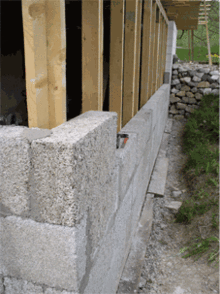
Concrete block made with hemp in France
Plastic and composite materials
A mixture of fiberglass, hemp fiber, kenaf, and flax has been used since 2002 to make composite panels for automobiles.[34] The choice of which bast fiber to use is primarily based on cost and availability. Various car makers are beginning to use hemp in their cars, including Audi, BMW, Ford, GM, Chrysler, Honda, Iveco, Lotus, Mercedes, Mitsubishi, Porsche, Saturn, Volkswagen[35] and Volvo. For example, the Lotus Eco Elise[36] and the Mercedes C-Class both contain hemp (up to 20 kg in each car in the case of the latter).[37]
-

Hemp plastic interior of a car door
-

Hemp plastic automobile glove box
-

Hemp plastic column, automobile
-

Hemp composite sink basin
Fiber sources
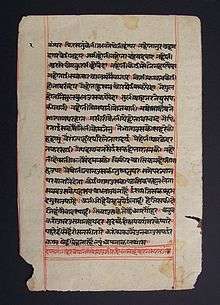
Before the industrialisation of the paper production the most common fibre source was recycled fibres from used textiles, called rags. The rags were from hemp, linen and cotton.[38] A process for removing printing inks from recycled paper was invented by German jurist Justus Claproth in 1774.[38] Today this method is called deinking. It was not until the introduction of wood pulp in 1843 that paper production was not dependent on recycled materials from ragpickers.[38]
History and development
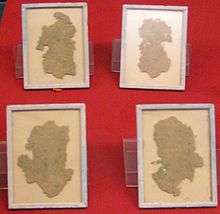
The first identified coarse paper, made from hemp, dates to the early Western Han Dynasty, two hundred years before the nominal invention of papermaking by Cai Lun, who improved and standardized paper production using a range of inexpensive materials, including hemp ends, approximately 2000 years ago.[39] Recycled hemp clothing, rags and fishing nets were used as inputs for paper production.
The Saint Petersburg, Russia, paper mill of Goznak opened in 1818. It used hemp as its main input material. Paper from the mill was used in the printing of "bank notes, stamped paper, credit bills, postal stamps, bonds, stocks, and other watermarked paper."[40]
In 1916, U.S. Department of Agriculture chief scientists Lyster Hoxie Dewey and Jason L. Merrill created paper made from hemp pulp and concluded that paper from hemp hurds was "favorable in comparison with those used with pulp wood."[41][42] The chemical composition of hemp hurds is similar to that of wood,[43] making hemp a good choice as a raw material for manufacturing paper. Modern research has not confirmed the positive finding about hemp hurds from 1916. A later book about hemp and other fibers by the same L.H. Dewey(1943) have no words about hemp as a raw material for production of paper.[44] Dried hemp has about 57% cellulose (the principal ingredient in paper), compared to about 40-50% in wood.[45][46][47] Hemp also has the advantage of a lower lignin content: hemp contains only 5-24% lignin[48] against the 20-35% found in wood.[49] This lignin must be removed chemically and wood requires more use of chemicals in the process.[50] The actual production of hemp fiber in the U.S continued to decline until 1933 to around 500 tons/year. Between 1934-35, the cultivation of hemp began to increase but still at a very low level and with no significant increase of paper from hemp.[51][52]
Contemporary
Currently there is a small niche market for hemp pulp, for example as cigarette paper.[53] Hemp fiber is mixed with fiber from other sources than hemp. In 1994 there was no significant production of 100% true hemp paper.[54] World hemp pulp production was believed to be around 120,000 tons per year in 1991 which was about 0.05% of the world's annual pulp production volume.[55] The total world production of hemp fiber had in 2003 declined to about 60,000 from 80,000 tons.[53] This can be compared to a typical pulp mill for wood fiber, which is never smaller than 250,000 tons per annum.[54][56] The cost of hemp pulp is approximately six times that of wood pulp,[55] mostly because of the small size and outdated equipment of the few hemp processing plants in the Western world, and because hemp is harvested once a year (during August) and needs to be stored to feed the mill the whole year through. This storage requires a lot of (mostly manual) handling of the bulky stalk bundles. Another issue is that the entire hemp plant cannot be economically prepared for paper production. While the wood products industry uses nearly 100% of the fiber from harvested trees, only about 25% of the dried hemp stem — the bark, called bast — contains the long, strong fibers desirable for paper production.[57] All this accounts for a high raw material cost. Hemp pulp is bleached with hydrogen peroxide, a process today also commonly used for wood pulp.
Market share
Around the year 2000, the production quantity of flax and hemp pulp total 25000-30000 tons per year, having been produced from approximately 37000-45000 tonnes fibers. Up to 80% of the produced pulp is used for specialty papers (including 95% of cigarette paper). Only about 20% hemp fiber input goes into the standard pulp area and are here mostly in lower quality (untreated oakum high shive content added) wood pulps. With hemp pulp alone, the proportion of specialty papers probably at about 99%. The market is considered saturated with little or no growth in this area.[58][59]
Jewelry

Hemp jewelry is the product of knotting hemp twine through the practice of macramé. Hemp jewellery includes bracelets, necklaces, anklets, rings, watches and other adornments. Some jewellery features beads made from glass, stone, wood and bones. The hemp twine varies in thickness and comes in a variety of colors. There are many different stitches used to create hemp jewellery, however, the half knot and full knot stitches are most common.
Cordage

Hemp rope was used in the age of sailing ships, though the rope had to be protected by tarring, since hemp rope has a propensity for breaking from rot, as the capillary effect of the rope-woven fibers tended to hold liquid at the interior, while seeming dry from the outside.[60] Tarring was a labor-intensive process, and earned sailors the nickname "Jack Tar". Hemp rope was phased out when Manila, which does not require tarring, became widely available. Manila is sometimes referred to as Manila hemp, but is not related to hemp; it is abacá, a species of banana.
Animal bedding
Hemp shives are the core of the stem, hemp hurds are broken parts of the core. In the EU, they are used for animal bedding (horses, for instance), or for horticultural mulch.[61] Industrial hemp is much more profitable if both fibers and shives (or even seeds) can be used.
Water and soil purification
Hemp can be used as a "mop crop" to clear impurities out of wastewater, such as sewage effluent, excessive phosphorus from chicken litter, or other unwanted substances or chemicals. Additionally Hemp is being used to clean contaminants at the Chernobyl nuclear disaster site. By way of a process which is known as phytoremediation - the process of clearing radioisotopes as well as a variety of other toxins from the soil, water, and air.[62]
Weed control

Hemp, because of its height, dense foliage and its high planting density as a crop, is a very effective and long used method of killing tough weeds in farming by minimizing the pool of weed seeds of the soil.[63] Using hemp this way can help farmers avoid the use of herbicides, to help gain organic certification and to gain the benefits of crop rotation. Due to its rapid, dense growth characteristics, in some jurisdictions hemp is considered a prohibited noxious weed, much like Scotch Broom.
Biofuels
Biodiesel can be made from the oils in hemp seeds and stalks and alcohol fuel (ethanol or, less commonly, methanol) from the fermentation of the whole plant. Biodiesel produced from hemp is sometimes known as "hempoline".[64]
Filtered hemp oil can be used directly to power diesel engines. In 1892, Rudolf Diesel invented the diesel engine, which he intended to power "by a variety of fuels, especially vegetable and seed oils, which earlier were used for oil lamps, i.e. the Argand lamp."[65][66][67]
Production of vehicle fuel from hemp is very small. Commercial biodiesel and biogas is typically produced from cereals, coconuts, palmseeds and cheaper raw materials like garbage, wastewater, dead plant and animal material, animal feces and kitchen waste.[68]
Cultivation

Hemp is usually planted between March and May in the northern hemisphere, between September and November in the southern hemisphere.[69] It matures in about three to four months.
Millennia of selective breeding have resulted in varieties that look quite different. Also, breeding since circa 1930 has focused quite specifically on producing strains which would perform very poorly as sources of drug material. Hemp grown for fiber is planted closely, resulting in tall, slender plants with long fibers. "Until the early 1900s industrial hemp was a valuable crop used all over the world for its strong fibers and oil seeds. Today, however, the common perception of the industrial hemp plant is generally negative and associated with the drug marijuana. This perception is the legacy of a century of powerful influences construing hemp as a dangerous drug, even though it is not a drug and it has the potential to be a profitable alternative crop. In the United States, the public's perception of hemp as marijuana has blocked hemp from becoming a useful crop and product,"[70] in spite of its vital importance prior to World War II.[71] Ideally, according to Britain's Department for Environment, Food and Rural Affairs, the herb should be desiccated and harvested towards the end of flowering. This early cropping reduces the seed yield but improves the fiber yield and quality.[72] In these strains of industrial hemp the tetrahydrocannabinol (THC) content would have been very low.[70]
The seeds are sown from mid-April to mid-May with grain drills to 4–6 cm sowing depth. Hemp needs less fertilizer than corn does. A total of 60–150 kg of nitrogen, 40–140 kg phosphorus (P2O5) and 75–200 kg of potassium [5] per acre for hemp fiber made before sowing and again later, maybe three to four weeks. When practiced, especially in France double use of fiber and seed fertilization with nitrogen doses up to 100 kg / ha rather low. Organic fertilizers such as manure can utilize industrial hemp well. Neither weeds nor crop protection measures are necessary.[70]
Cultivars
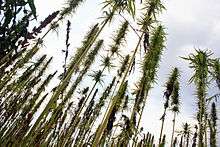
A total of 26 varieties of hemp with low levels of tetrahydrocannabinol (THC) are certified by the European Union (EU).[73] They have, unlike other types, a very high fiber content of 30-40%. In contrast to cannabis for medical use, varieties grown for fiber and seed have less than 0.2% THC and they are unsuitable for producing hashish and marijuana.[74] The most important cannabinoid in industrial hemp is cannabidiol (CBD) with a proportion of 1 to 5%.
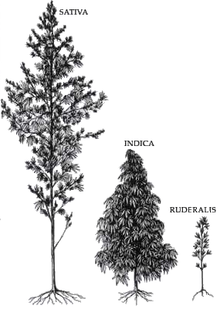
Cannabis sativa L. subsp. sativa var. sativa is the variety grown for industrial use, while C. sativa subsp. indica generally has poor fiber quality and female buds from this variety are primarily used for recreational and medicinal purposes. The major differences between the two types of plants are the appearance, and the amount of Δ9-tetrahydrocannabinol (THC) secreted in a resinous mixture by epidermal hairs called glandular trichomes, although they can also be distinguished genetically.[75] Oilseed and fiber varieties of Cannabis approved for industrial hemp production produce only minute amounts of this psychoactive drug, not enough for any physical or psychological effects. Typically, hemp contains below 0.3% THC, while cultivars of Cannabis grown for medicinal or recreational use can contain anywhere from 2% to over 20%.[76]
Harvesting

Smallholder plots are usually harvested by hand. The plants are cut at 2 to 3 cm above the soil and left on the ground to dry. Mechanical harvesting is now common, using specially adapted cutter-binders or simpler cutters.
The cut hemp is laid in swathes to dry for up to four days. This was traditionally followed by retting, either water retting (the bundled hemp floats in water) or dew retting (the hemp remains on the ground and is affected by the moisture in dew, and by molds and bacterial action).
Location and crop rotation
For profitable hemp farming, particularly deep, humus-rich, nutrient-rich soil with controlled water flow is preferable. Waterlogged acidic, compressed or extremely light (sandy) soils primarily affect the early development of plants. Steep and high altitudes of more than 400 m above sea level are best avoided. Hemp is relatively insensitive to cold temperatures and can withstand frost down to −5 °C. Seeds can germinate down to 1–3 °C. Hemp needs a lot of heat, so earlier varieties come to maturation. The water requirement is 300–500 l/kg dry matter. Up to 3 feet growing roots into the soil can also use water supplies from deeper soil layers. Worth noting is that the water requirement of hemp is at least 14 times lower than that of cotton, which takes between 7,000 and 29,000 l/kg, according to WWF.
Hemp benefits crops grown after it. For this reason, it is generally grown before winter cereals. Advantageous changes are high weed suppression, soil loosening by the large hemp root system and the positive effect on soil tilth. Since hemp is very self-compatible, it can also be grown several years in a row in the same fields (monoculture).
Diseases
Hemp plants can be vulnerable to various pathogens, including bacteria, fungi, nematodes, viruses and other miscellaneous pathogens. Such diseases often lead to reduced fiber quality, stunted growth, and death of the plant. These diseases rarely affect the yield of a hemp field, so hemp production is not traditionally dependent on the use of pesticides.
Environmental impact
Hemp is considered by a 1998 study in Environmental Economics to be environmentally friendly due to a decrease of land use and other environmental impacts, indicating a possible decrease of ecological footprint in a US context compared to typical benchmarks.[77] A 2010 study, however, that compared the production of paper specifically from hemp and eucalyptus concluded that "industrial hemp presents higher environmental impacts than eucalyptus paper"; however, the article also highlights that "there is scope for improving industrial hemp paper production".[78] Hemp is also claimed to require few pesticides and no herbicides, and it has been called a carbon negative raw material.[79][80] Results indicate that high yield of hemp may require high total nutrient levels (field plus fertilizer nutrients) similar to a high yielding wheat crop.[81]
Producers
|
Hemp production in tonnes 2003 & 2013 | |||||
| | 4300 | 14 % | 48264 | 71 % | |
| | 24000 | 79 % | 16000 | 24 % | |
| | 1250 | 4 % | 1450 | 2% | |
| | 150 | < 1% | 1450 | 1% | |
| | 40 | < 1% | 600 | < 1% | |
| | 300 | 1 % | 300 | <1 % | |
| | 100 | < 1% | 150 | < 1% | |
| | 15 | < 1% | 30 | < 1% | |
| | 150 | < 1% | 1 | < 1% | |
| | 8 | < 1% | 0 | 0% | |
| | 2 | < 1% | 0% | ||
| Total | 30315 | 100 % | 67785 | 100% | |
The world-leading producer of hemp is France, which produces more than 70% of the world output. China ranks second with approximately a quarter of the world production. There is smaller production in Europe, Chile and North Korea. Over thirty countries produce industrial hemp, including Australia, Austria, Canada, Chile, China, Denmark, Egypt, Finland, Germany, Great Britain, Hungary, India, Italy, Japan, Korea, Netherlands, New Zealand, Poland, Portugal, Romania, Russia, Slovenia, Spain, Sweden, Switzerland, Thailand, Turkey and Ukraine.[82][83]
The United Kingdom and Germany resumed commercial production in the 1990s. British production is mostly used as bedding for horses; other uses are under development. Companies in Canada, the UK, the United States and Germany, among many others, process hemp seed into a growing range of food products and cosmetics; many traditional growing countries still continue to produce textile-grade fibre.

Air dry stem yields in Ontario have from 1998 and onward ranged from 2.6-14.0 tonnes of dry, retted stalks per hectare (1-5.5 t/ac) at 12% moisture. Yields in Kent County, have averaged 8.75 t/ha (3.5 t/ac). Northern Ontario crops averaged 6.1 t/ha (2.5 t/ac) in 1998. Statistic for the European Union for 2008 to 2010 say that the average yield of hemp straw has varied between 6.3 and 7.3 ton per ha.[84][85] Only a part of that is bast fiber. Approximately one tonne of bast fiber and 2-3 tonnes of core material can be decorticated from 3-4 tonnes of good quality, dry retted straw. For an annual yield of this level is it in Ontario recommended to add nitrogen (N):70–110 kg/ha, phosphate (P2O5): up to 80 kg/ha and potash (K2O): 40–90 kg/ha.[86] The average yield of dry hemp stalks in Europe was 6 ton/ha (2.4 ton/ac) in 2001 and 2002.[14]
FAO argue that an optimum yield of hemp fiber is more than 2 tonnes per ha, while average yields are around 650 kg/ha.[87]
Australia
In the Australian states of Tasmania, Victoria, Queensland and, most recently, New South Wales, the state governments have issued licences to grow hemp for industrial use. The first to initiate modern research into the potential of cannabis was the state of Tasmania pioneered the licensing of hemp during the early 1990s. The state of Victoria was an early adopter in 1998, and has reissued the regulation in 2008.[88]
Queensland has allowed industrial production under licence since 2002,[89] where the issuance is controlled under the Drugs Misuse Act 1986.[90] Most recently, New South Wales now issues licences[91] under a law, the Hemp Industry Regulations Act 2008 (No 58), that came into effect as of 6 November 2008.[92]
Canada
Commercial production (including cultivation) of industrial hemp has been permitted in Canada since 1998 under licenses and authorization issued by Health Canada (9,725 ha in 2004, 5450 ha in 2009).[93]
In the early 1990s, industrial hemp agriculture in North America began with the Hemp Awareness Committee at the University of Manitoba. The Committee worked with the provincial government to get research and development assistance, and was able to obtain test plot permits from the Canadian government. Their efforts led to the legalization of industrial hemp (hemp with only minute amounts of tetrahydrocannabinol) in Canada and the first harvest in 1998.[94][95]
The cultivated area for hemp in the Prairie provinces of Canada is stable at about 90,000 acres (36,000 ha) over 2013-15.[96]
France

France is the world's biggest producer with 8,000 hectares cultivated. 70-80% of the hemp fibre produced in Europe in 2003 was used for specialty pulp for cigarette papers and technical applications. About 15% is used in the automotive sector and 5-6% were used for insulation mats. Approximately 95% of hurds were used as animal bedding, while almost 5% were used in the building sector.[14] In 2010/2011, a total of 11 000 ha was cultivated with hemp in the EU, a decline compared with previous year.[85][97]
Russia and Ukraine
.png)
From the 1950s to the 1980s, the Soviet Union was the world's largest producer of hemp (3,000 km² in 1970). The main production areas were in Ukraine,[98] the Kursk and Orel regions of Russia, and near the Polish border. Since its inception in 1931, the Hemp Breeding Department at the Institute of Bast Crops in Hlukhiv (Glukhov), Ukraine, has been one of the world's largest centers for developing new hemp varieties, focusing on improving fiber quality, per-hectare yields, and low THC content.[99][100]
After the collapse of the Soviet Union, the commercial cultivation of hemp declined sharply. However, it is estimated that at least 2.5 million acres of hemp grows wild in the Russian Far East and Black Sea regions.[101]
United Kingdom
In the United Kingdom, cultivation licences are issued by the Home Office under the Misuse of Drugs Act 1971. When grown for non-drug purposes, hemp is referred to as industrial hemp, and a common product is fibre for use in a wide variety of products, as well as the seed for nutritional aspects and for the oil. Feral hemp or ditch weed is usually a naturalized fibre or oilseed strain of Cannabis that has escaped from cultivation and is self-seeding.[102]
United States
Hemp was made illegal to grow without a permit in the U.S. under the Controlled Substances Act passed in 1970 because of its relation to marijuana,[17] and any imported hemp products must meet a zero tolerance level.[103] Some states have made the cultivation of industrial hemp legal, but farmers in many states have not yet begun to grow it because of resistance from the federal Drug Enforcement Administration.[104] In 2013, after the legalization of cannabis in the state, several farmers in Colorado planted and harvested several acres of hemp, bringing in the first hemp crop in the United States in over half a century.[105] Colorado,[106] Vermont, California, and North Dakota have passed laws enabling hemp licensure. All four states are waiting for permission to grow hemp from the DEA. Currently,[107] Oregon has licensed industrial hemp as of August 2009.[108] Congress included a provision in the Agricultural Act of 2014 that allowed colleges and state agencies to grow and conduct research on hemp in states where it is legal.[17] Hemp production in Kentucky, formerly the United States' leading producer, resumed in 2014.[109]
As of 2015 the hemp industry estimated that annual sales of hemp products were around US$580 million annually; hemp seeds have been the major force driving this growth.[110]
Yet, even with this progress, hemp businesses seem to face difficulty expanding in the US as they face challenges in traditional marketing and sales approaches.[111] According to the case study done by Forbes, hemp businesses and startups, such as Ministry of Hemp,[112] have had difficulty marketing and selling non-psychoactive hemp products, as social media and financial institutions refuse to distinguish between hemp and marijuana.
History

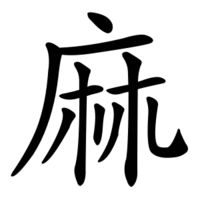
Hemp is one of the earliest domesticated plants known.[114] It has been cultivated by many civilizations for over 12,000 years.[115] Hemp use archaeologically dates back to the Neolithic Age in China, with hemp fiber imprints found on Yangshao culture pottery dating from the 5th millennium BC.[113][116] The Chinese later used hemp to make clothes, shoes, ropes, and an early form of paper.[113] The classical Greek historian Herodotus (ca. 480 BC) reported that the inhabitants of Scythia would often inhale the vapors of hemp-seed smoke, both as ritual and for their own pleasurable recreation.[117]
Textile expert Elizabeth Wayland Barber summarizes the historical evidence that Cannabis sativa, "grew and was known in the Neolithic period all across the northern latitudes, from Europe (Germany, Switzerland, Austria, Romania, Ukraine) to East Asia (Tibet and China)," but, "textile use of Cannabis sativa does not surface for certain in the West until relatively late, namely the Iron Age."[118] "I strongly suspect, however, that what catapulted hemp to sudden fame and fortune as a cultigen and caused it to spread rapidly westwards in the first millennium B.C. was the spread of the habit of pot-smoking from somewhere in south-central Asia, where the drug-bearing variety of the plant originally occurred. The linguistic evidence strongly supports this theory, both as to time and direction of spread and as to cause."[119]
Jews living in Palestine in the 2nd century were familiar with the cultivation of hemp, as witnessed by a reference to it in the Mishna (Kil'ayim 2:5) as a variety of plant, along with Arum, that sometimes takes as many as three years to grow from a seedling. In late medieval Germany and Italy, hemp was employed in cooked dishes, as filling in pies and tortes, or boiled in a soup.[120] Hemp in later Europe was mainly cultivated for its fibers, and was used for ropes on many ships, including those of Christopher Columbus. The use of hemp as a cloth was centered largely in the countryside, with higher quality textiles being available in the towns.
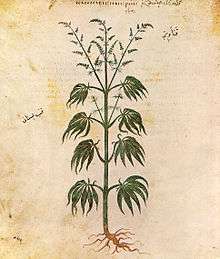
The Spaniards brought hemp to the Western Hemisphere and cultivated it in Chile starting about 1545.[121] However, in May 1607, "hempe" was among the crops Gabriel Archer observed being cultivated by the natives at the main Powhatan village, where Richmond, Virginia is now situated;[122] and in 1613, Samuell Argall reported wild hemp "better than that in England" growing along the shores of the upper Potomac. As early as 1619, the first Virginia House of Burgesses passed an Act requiring all planters in Virginia to sow "both English and Indian" hemp on their plantations.[123] The Puritans are first known to have cultivated hemp in New England in 1645.[121]
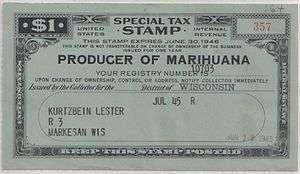
George Washington pushed for the growth of hemp and even grew hemp himself, as it was a cash crop commonly used to make rope and fabric. In May 1765 he noted in his diary about the sowing of seeds each day until mid-April. Then he recounts the harvest in October which he grew 27 bushels that year.
There is some speculation that George Washington smoked the flower of the cannabis plant in order to achieve a recreational high ("Like all farmers, Washington probably sampled the quality and potency of what he grew, and he may have used this hemp to treat his chronic tooth aches"),[71] but there is no evidence in any of his writings that he grew hemp for anything other than industrial purposes. It is sometimes supposed that an excerpt from Washington's diary, which reads "Began to seperate [sic] the Male from the Female hemp at Do.&—rather too late" is evidence that he was trying to grow female plants for the THC found in the flowers. However, the editorial remark accompanying the diary states that "This may arise from their [the male] being coarser, and the stalks larger"[124] In subsequent days, he describes soaking the hemp[125] (to make the fibers usable) and harvesting the seeds,[126] suggesting that he was growing hemp for industrial purposes, not recreational.
George Washington also imported the Indian Hemp plant from Asia, which was used for fiber and, by some growers, for intoxicating resin production. In a letter to William Pearce who managed the plants for him Washington says, "What was done with the Indian Hemp plant from last summer? It ought, all of it, to be sown again; that not only a stock of seed sufficient for my own purposes might have been raised, but to have disseminated seed to others; as it is more valuable than common hemp."
Additional presidents known to have farmed hemp include Thomas Jefferson,[127] James Madison, James Monroe, Andrew Jackson, Zachary Taylor, and Franklin Pierce. [128]
Historically, hemp production had made up a significant portion of antebellum Kentucky's economy. Before the American Civil War, many slaves worked on plantations producing hemp.[129]
In 1937, the Marihuana Tax Act of 1937 was passed in the United States. levying a tax on anyone who dealt commercially in cannabis, hemp, or marijuana. The passing of the Act to destroy the US hemp industry has been disputed to involve businessmen Andrew Mellon, Randolph Hearst and the Du Pont family.[130][131][132]
One claim is that Hearst believed that his extensive timber holdings were threatened by the invention of the decorticator which he feared would allow hemp to become a cheap substitute for the paper pulp used for newspaper.[130][133] Historical research indicates this fear was unfounded because improvements of the decorticators in the 1930s – machines that separated the fibers from the hemp stem – could not make hemp fiber a cheaper substitute for fibers from other sources. Further, decorticators did not perform satisfactorily in commercial production.[44][130]
Another claim is that Mellon, Secretary of the Treasury and the wealthiest man in America at that time, had invested heavily in DuPont's new synthetic fiber, nylon, and believed that the replacement of the traditional resource, hemp, was integral to the new product's success.[130][134][135][136][137][138][139][140] The company DuPont and many industrial historians dispute a link between nylon and hemp, nylon became immediately a scarce commodity. Nylon had characteristics that could be used for toothbrushes (sold from 1938) and very thin nylon fiber could compete with silk and rayon in various textiles normally not produced from hemp fiber, such as very thin stockings for women.[44][141][142][143][144]
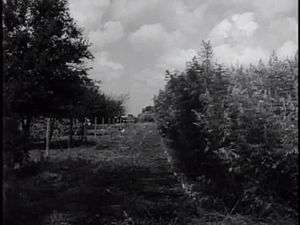
Hemp was used extensively by the United States during World War II to make uniforms, canvas, and rope.[145] Much of the hemp used was cultivated in Kentucky and the Midwest. During World War II, the U.S. produced a short 1942 film, Hemp for Victory, promoting hemp as a necessary crop to win the war.
Historical cultivation
Hemp has been grown for millennia in Asia and the Middle East for its fibre. Commercial production of hemp in the West took off in the eighteenth century, but was grown in the sixteenth century in eastern England.[146] Because of colonial and naval expansion of the era, economies needed large quantities of hemp for rope and oakum. In the early 1940s, world production of hemp fiber ranged from 250 000 to 350 000 metric tonnes, Russia was the biggest producer.[44]
In Western Europe, the cultivation of hemp was not legally banned by the 1930s, but the commercial cultivation stopped by then, due to decreased demand compared to increasingly popular artificial fibers.[147] Speculation about the potential for commercial cultivation of hemp in large quantities has been criticized due to successful competition from other fibers for many products. The world production of hemp fiber fell from over 300,000 metric tons 1961 to about 75,000 metric tons in the early 1990s and has after that been stable at that level.[148]
Japan

In Japan, hemp was historically used as paper and a fiber crop. There is archaeological evidence cannabis was used for clothing and the seeds were eaten in Japan back to the Jōmon period (10,000 to 300 BCE). Many Kimono designs portray hemp, or asa (Japanese: 麻), as a beautiful plant. In 1948, marijuana was restricted as a narcotic drug. The ban on marijuana imposed by the United States authorities was alien to Japanese culture, as the drug had never been widely used in Japan before. Though these laws against marijuana are some of the world's strictest, allowing five years imprisonment for possession of the drug, they exempt hemp growers, whose crop is used to make robes for Buddhist monks and loincloths for Sumo wrestlers. Because marijuana use in Japan has doubled in the past decade, these exemptions have recently been called into question.[149]
Portugal
The cultivation of hemp in Portuguese lands began around the fourteenth century onwards, it was raw material for the preparation of rope and plugs for the Portuguese ships. Colonies for factories for the production of flax hemp, such as the Royal Flax Hemp Factory in Brazil.
After the Restoration of Independence in 1640, in order to recover the ailing Portuguese naval fleet, were encouraged its cultivation as the Royal Decree of D. John IV in 1656. At that time its cultivation was carried out in Trás-os-Montes, Zone Tower Moncorvo, more precisely in Vilariça Valley, fertile land for any crop irrigation, and a very large area, flat and very fertile culture still wide until the last century grew up tobacco, a plant that needs a large space to expand and grow, the area lies in the valley of Serra de Bornes.
In 1971, the cultivation of hemp became illegal, and the production was substantially reduced. Because of EU regulations 1308/70, 619/71 and 1164/89, this law was revoked (for some certified seed varieties).[150]
See also
References
- ↑ http://tfd.com/hemp
- ↑ Swanson, TE (2015), "Controlled Substances Chaos: The Department of Justice's New Policy Position on Marijuana and What It Means for Industrial Hemp Farming in North Dakota" (PDF), North Dakota Law Review, 90 (3): 613
- ↑ Robert Deitch (2003). Hemp: American History Revisited: The Plant with a Divided History. Algora Publishing. p. 219. ISBN 978-0-87586-226-2.
- ↑ Tourangeau, Wesley (2015), "Re-defining Environmental Harms: Green Criminology and the State of Canada's Hemp Industry", Canadian Journal of Criminology & Criminal Justice, 57 (4): 528–554, doi:10.3138/cjccj.2014.E11
- 1 2 Keller, NM (2013), "The Legalization of Industrial Hemp and What it Could Mean for Indiana's Biofuel Industry" (PDF), Indiana International & Comparative Law Review, 23 (3): 555, doi:10.18060/17887
- 1 2 Swanson 2015, p. 602.
- ↑ Talbot, Geoff (2015). Specialty Oils and Fats in Food and Nutrition: Properties, Processing and Applications. Elsevier Science. p. 39. ISBN 978-1-78242-397-3.
- ↑ Crime, United Nations Office on Drugs and (2009). Recommended Methods for the Identification and Analysis of Cannabis and Cannabis Products: Manual for Use by National Drug Testing Laboratories. United Nations Publications. p. 12. ISBN 978-92-1-148242-3.
- 1 2 3 4 Mallory, JP (1997), JP Mallory and DQ Adams, eds., Encyclopedia of Indo-European Culture (Illustrated ed.), London, UK: Taylor & Francis, p. 266, ISBN 9781884964985
- ↑ Adams, DQ (2006), JP Mallory and DQ Adams, eds., The Oxford Introduction to Proto-Indo-European and the Proto-Indo-European World, Oxford University Press, p. 166, ISBN 9780191058127
- 1 2 3 Barber, EJW (1991), Prehistoric Textiles: The Development of Cloth in the Neolithic and Bronze Ages with Special Reference to the Aegean, Princeton University Press, pp. 36–38, ISBN 9780691002248
- ↑ McConvell, Patrick; Smith, Michael (2003), "Millers and Mullers: The archaeo-linguisitic stratigraphy of technological change in holocene Australia", in Henning Andersen, Language Contacts in Prehistory: Studies in Stratigraphy, John Benjamins Publishing, p. 181, ISBN 9781588113795
- ↑ "Erowid Cannabis Vault : Culture #2". erowid.org. Retrieved 2008-06-20.
- 1 2 3 "Michael Karus: European Hemp Industry 2002 Cultivation, Processing and Product Lines. Journal of Industrial Hemp Volume 9 Issue 2 2004, Taylor & Francis, London". Informaworld.com. Retrieved 2011-04-20.
- ↑ "America's First Hemp Drink - Chronic Ice - Making a Splash in the Natural Beverage Market". San Francisco Chronicle. Los Angeles. Vocus. 8 June 2011. Archived from the original on 2011-12-27. Retrieved 19 June 2011.
- 1 2 3 "USDA ERS - Industrial Hemp in the United States: Status and Market Potential" (PDF). Ers.usda.gov. Retrieved 2013-11-09.
- 1 2 3 "Farm bill promotes hemp as legal crop". Leg.state.or.us. Retrieved 2014-02-05.
- ↑ "Industrial fibre crops: business opportunities for farmers", gov.uk, Department for Environment, Food & Rural Affairs, 13 Jun 2013, retrieved 18 May 2016
- 1 2 "Nutrition Facts for Hemp Seeds (shelled) per 100 g serving". Conde Nast, Custom Analysis. 2014. Retrieved 19 February 2015.
- 1 2 Callaway, J. C. (2004-01-01). "Hempseed as a nutritional resource: An overview" (PDF). Euphytica. Kluwer Academic Publishers. 140 (1–2): 65–72. doi:10.1007/s10681-004-4811-6. Retrieved 2013-03-13.
- ↑ House JD, Neufeld J, Leson G; Neufeld; Leson (November 2010). "Evaluating the quality of protein from hemp seed (Cannabis sativa L.) products through the use of the protein digestibility-corrected amino acid score method". Journal of Agricultural and Food Chemistry. 58 (22): 11801–7. doi:10.1021/jf102636b. PMID 20977230.
- ↑ "CRRH, Archaeologists agree that cannabis was among the first crops cultivated by human beings at least over 6,000 years ago, and perhaps more than 12,000 years ago". Crrh.org. Retrieved 2011-04-20.
- ↑ "Online Etymology Dictionary". Etymonline.com. Retrieved 2011-04-20.
- ↑ "Green bedrooms and more: Healthy fabrics for the home". The Ottawa Citizen. 2008-04-10.
- ↑ Cronin, Mary Elizabeth (1995-02-11). "Hemp fashions are clean, comfy, and legal". The Free Lance-Star.
- ↑ NNFCC. "NNFCC Project Factsheet: Guide to Building with Hemp-Lime Composites, NNFCC 07-001", "National Non-Food Crops Centre", Retrieved on 16 Feb 2011
- ↑ Isabelle, Ceyte (2008). Etat,acteurs privés et innovation dans le domaine des matériaux de construction écologiques : Le développement du béton de chanvre depuis 1986 (PDF) (MASTER - Politiques publiques et gouvernements comparés thesis) (in French). 'Institut d'Etudes Politiques de Lyon.
- ↑ "The Haverhill Hemp Houses". bre.co.uk. Retrieved 2013-02-08.
- ↑ "Modece Architects". modece.com. Retrieved 2013-02-08.
- ↑ "The NNFCC Renewable House". Renewable-house.co.uk. Retrieved 2011-04-20.
- ↑ "Hemp homes are cutting edge of green building". USA Today. 2010-09-12.
- ↑ "HEMPSEC project website". European Union research. Retrieved 8 July 2014.
- ↑ Allin, Steve. Building with Hemp, Seed Press, 2012, ISBN 978-0-9551109-1-7. (p. 95, 2nd Edition).
- ↑ "Thermoformable Composite Panels" (PDF). Composites World. 2006.
- ↑ "Plastics". hemp.com. 2013-05-14. Retrieved 2013-11-09.
- ↑ "Lotus announces hemp-based Eco Elise: a new type of 'green' car". transport20.com. Retrieved 2013-11-09.
- ↑ "Green Cars, Fuel Efficiency and the Environment | Mercedes-Benz". Mbusa.com. Retrieved 2013-11-09.
- 1 2 3 Göttsching, Lothar; Pakarinen, Heikki (2000), "1", Recycled Fiber and Deinking, Papermaking Science and Technology, 7, Finland: Fapet Oy, pp. 12–14, ISBN 952-5216-07-1
- ↑ "Cai Lun Improved the Papermaking Technology". chinaculture.org.
- ↑ A brief history of the St. Petersburg Paper Mill of Goznak (www.goznak.spb.ru) Archived May 28, 2006, at the Wayback Machine.
- ↑ Dewey and Merrill, U.S.D.A. Bulletin No. 404, Hemp Hurds as Paper-Making Material, Washington, D.C., October 14, 1916. Page 25
- ↑ "The Project Gutenberg eBook of Hemp Hurds as Paper-Making Material, by Lyster H. Dewey and Jason L. Merrill". Gutenberg.org. Retrieved 2011-04-20.
- ↑ Stevulova, Nadezda (December 2014). "Properties Characterization of Chemically Modified Hemp Hurds". Materials. 7: 8131–8150. doi:10.3390/ma7128131.
- 1 2 3 4 Dewey LH (1943). "Fiber production in the western hemisphere". United States Printing Office, Washington. p. 67. Retrieved 25 February 2015.
- ↑ Cellulose. (2008). In Encyclopædia Britannica. Retrieved January 11, 2008, from Encyclopædia Britannica Online.
- ↑ Chemical Composition of Wood. ipst.gatech.edu.
- ↑ Piotrowski, Stephan and Carus, Michael (May 2011) Multi-criteria evaluation of lignocellulosic niche crops for use in biorefinery processes. nova-Institut GmbH, Hürth, Germany.
- ↑ Multi-criteria evaluation of lignocellulosic niche crops for use in biorefinery processes. nova-Institut GmbH, Hürth, Germany.
- ↑ Li Jingjing (2011) Isolation of Lignin from Wood. SAIMAA UNIVERSITY OF APPLIED SCIENCES.
- ↑ "Papper". Hampa.net. Retrieved 2013-11-09.
- ↑ "David P. West: Fiber Wars: The Extinction of Kentucky Hemp". Gametec.com. Retrieved 2011-04-20.
- ↑ "Additional Statement of H.J. Anslinger, Commissioner of Narcotics". Retrieved 2006-03-25.
- 1 2 "Michael Karus:European hemp industry 2001 till 2004: Cultivation, raw materials, products and trends, 2005" (PDF). Retrieved 2011-04-20.
- 1 2 "Steam energy:Hemp Pulp & Paper Production, January 1st 1994". Hempline.com. Retrieved 2011-04-20.
- 1 2 Van Roekel; Gerjan J. (1994). "Hemp Pulp and Paper Production". Journal of the International Hemp Association. Wageningen, The Netherlands.
- ↑ "Anatomy of a Modern Paper Mill, Faculty of Natural Resources Management, Lakehead University". Borealforest.org. Retrieved 2013-11-09.
- ↑ "Boise: Nonwood Alternatives to Wood Fiber in Paper". bc.com. 2007-07-08. Archived from the original on July 8, 2007. Retrieved 2013-11-09.
- ↑ Ivan Bócsa, Michael Karus, Daike Lohmeyer: The cultivation of hemp. Botany, varieties, cultivation and harvesting, markets and product lines. 2 support, agricultural Verlag GmbH, Münster 2000th
- ↑ Michael Carus et al. Study of market and competition for natural fibers and natural fiber materials (Germany and EU) trade talks Gülzower 26, ed. of the Agency of Renewable Resources, Gülzow 2008 Download nova-Institut (ed.): The small hemp-Lexikon Verlag The Workshop, Göttingen, 2. Edition, 2003, page 79 ISBN 3-89533-271-2
- ↑ Schubert, Pit. "Our ropes are much stronger than we believe". Union Internationale Des Associations D'Alpinisme. Archived from the original on September 27, 2007.
- ↑ NNFCC. In the US, pet manufacturers use hemp in dog and cat bedding. "Crop Factsheet: Hemp", National Non-Food Crops Centre, 2008-06-09. Retrieved on 2009-05-06
- ↑ "Phytoremediation: Using Plants to Clean Soil". Mhhe.com. Retrieved 2011-04-20.
- ↑ "Hemp As Weed Control". gametec.com. Retrieved 2008-07-09.
- ↑ "COOLFUEL Episode: Sugarcane and Hempoline". Retrieved 2009-10-16.
- ↑ "Clean Energy Solutions". Hemp 4 Fuel. Retrieved 2011-04-20.
- ↑ "Pollution: Petrol vs. Hemp". Hempcar.org. Retrieved 2011-04-20.
- ↑ "Biofuels Facts". Hempcar.org. Retrieved 2011-04-20.
- ↑ "Increased biogas production at the Henriksdals Waste Water plant, Cajsa Hellstedt et. all, June 2010" (PDF).
- ↑ Hemp Cultivation (www.green.net.au) Archived February 19, 2011, at the Wayback Machine.
- 1 2 3 This paper begins with a history of hemp use and then describes how hemp was constructed as a dangerous crop in the U.S. The paper then discusses the potential of hemp as an alternative crop. Luginbuhl, April M. (2001). "Industrial hemp (Cannabis sativa L): The geography of a controversial plant". The California Geographer (PDF). 41. California Geographical Society. pp. 1–14. Retrieved 2013-03-28.
Hemp contains less than 1% THC, or tetrahydrocannabinols, the psychoactive property in marijuana. In other words, smoking hemp cannot create a 'high.' ... The dense growth of hemp eliminates other weeds.... The best growing technique for hemp, planting 300 to 500 plants per square meter, also helps authorities easily tell the hemp from marijuana, which is a plant that is less densely cultivated. (Roulac 1997; 149).
- 1 2 Deitch, Robert (2003). Hemp: American History Revisited: The Plant with a Divided History. Algora Publishing. pp. 4–26. ISBN 9780875862262. Retrieved 2013-11-16.
Cannabis is ... a plant that played an important role in colonial America's prosperous economy and remained a valuable commercial commodity up until the Second World War.
- ↑ http://archive.defra.gov.uk/foodfarm/growing/crops/industrial/pdf/flaxhemp-report.pdf
- ↑ "Bundesanstalt für Landwirtschaft und Ernährung: ''FÜR DIREKTZAHLUNGEN IN BETRACHT KOMMENDE HANFSORTEN''" (PDF) (in German). Retrieved 2015-03-06.
- ↑ Frank Waskow (1995), Katalyse-Institut für Angewandte Umweltforschung, ed. (in German), Hanf & Co.: die Renaissance der heimischen Faserpflanzen, Göttingen: Verlag Die Werkstatt, pp. 45, ISBN 3-89533-138-4
- ↑ Datwyler, SL; Weiblen, GD (2006). "Genetic Variation in Hemp and marijuana (Cannabis sativa L.) sativa plants are taller and less dense. Indica plants are shorter but a lot more dense than sativas. According to Amplified Fragment Length Polymorphisms". Journal of Forensic Sciences. 51 (2): 371–375. doi:10.1111/j.1556-4029.2006.00061.x.
- ↑ Hemp and Marijuana: Myths & Realities written by David P. West, Ph.D. for the North American Industrial Hemp Council
- ↑ "Industrial hemp's double dividend: a study for the USA". Ecological Economics. 25: 291–301. 1998-06-30. doi:10.1016/S0921-8009(97)00040-2. Retrieved 2013-11-09.
- ↑ "Industrial hemp or eucalyptus paper?". The International Journal of Life Cycle Assessment. 15: 368–375. doi:10.1007/s11367-010-0152-y. Retrieved 2013-11-09.
- ↑ "FAQs & Facts: Facts". Resources: Education. The HIA. Retrieved 2008-07-05.
- ↑ "HIA: Resources: Education: FAQs & Facts: FAQs: Answers". thehia.org. Retrieved 2008-07-05.
- ↑ "D. Risula, and others, Saskatchewan Ministry of Agriculture, October 2009". Retrieved 2011-04-20.
- ↑ "Hemp vs. Marijuana". azhemp.org. Retrieved 2008-06-18.
- ↑ "Hemp Facts". thehia.org. Retrieved 2013-11-09.
- ↑ Carus, Michael (June 2013). "The European Hemp Industry: Cultivation, processing and applications for fibres, shivs and seeds" (PDF). European Industrial Hemp Association. Retrieved 2016-08-30.
- 1 2 "Agriculture in the European Union, Statistical and Economic Information 2011, European Union Directorate-General for Agriculture and Rural Development, page 283" (PDF). Retrieved 2013-11-09.
- ↑ "Growing Industrial Hemp in Ontario, Ministry of Agriculture, Food and Rural Affairs, Canada, 2008". ON, CA: Omafra. Retrieved 2011-04-20.
- ↑ Graeme Thomas. "Natural Fibers: Hemp Food and Agriculture Organization of the United Nations, 2009". Naturalfibres2009.org. Retrieved 2011-04-20.
- ↑ "Drugs, Poisons and Controlled Substances (Industrial Hemp) Regulations 2008" (PDF). dms.dpc.vic.gov.au. Retrieved 2008-11-24.
- ↑ "Guidelines for engaging in the commercial production of industrial hemp in Queensland". dpi.qld.gov.au. Archived from the original on December 20, 2008. Retrieved 2008-11-24.
- ↑ "Drugs Misuse Act 1986" (PDF). legislation.qld.gov.au. Retrieved 2008-11-24.
- ↑ "Opportunities to engage in commercial low THC hemp fibre and seed production in NSW". dpi.nsw.gov.au. Retrieved 2008-11-24.
- ↑ "Hemp Industry Regulation 2008". legislation.nsw.gov.a. Retrieved 2008-11-24.
- ↑ "Government of Alberta: Industrial Hemp Production in Canada, February 2, 2010". .agric.gov.ab.ca. Retrieved 2011-04-20.
- ↑ "Where the heck is hemp?, The Alberta Express, April 18th, 2007". www.hempline.com.
- ↑ "Manitoba Harvest 2007 Peoples Choice, Eco Libris, Oct 8th, 2007". ecolibris.blogspot.ca/.
- ↑ Arnason R (29 January 2015). "Interest high in hemp, but acres stable". The Western Producer. Retrieved 30 March 2015.
- ↑ Jordbruksverket: 2.1–2.3, 2.5 Marknadssituationen för spannmål, oljeväxter, proteingrödor, ris,2011-03-10, (Swedish Board of Agriculture, Report from an expert group in the European Union about the market situation for a number of agricultural products. Published only in Swedish) Archived January 18, 2012, at the Wayback Machine.
- ↑ "Hemp research and growing in Ukraine". Aginukraine.com. 2002-01-06. Retrieved 2011-04-20.
- ↑ Hemp will help Ukraine to grow wealthy (Russian)
- ↑ Interview with Dr. V. G. Virovets, the head of the Hemp Breeding Department at the Institute of Bast Crops (1998) (English)
- ↑ "(Website/ Products)". Retrieved Sep 28, 2011.
- ↑ Jon Merrills; Jonathan Fisher (2013). Pharmacy Law and Practice. Academic Press. p. 227. ISBN 978-0-12-394618-8.
- ↑ Frank J. House (2006). Agricultural Programs, Terms and Laws. Nova Publishers. p. 146. ISBN 978-1-59454-892-5.
- ↑ ncsl.org
- ↑ "Hemp, hemp, hooray: Bill aims to aid farmers with new but controversial crop". Minnesotaindependent.com. Retrieved 2011-04-20.
- ↑ Colorado Amendment 64
- ↑ "North Dakota". hemp.org.
- ↑ "75th Oregon Legislative Assembly — 2009 Regular Session Senate Bill 676". Leg.state.or.us. Retrieved 2011-04-20.
- ↑ Gregory A. Hall (February 17, 2014), "Kentucky announces 5 hemp pilot projects", The Courier-Journal – via USA Today
- ↑ Johnson, Renée (2015-02-02). "Hemp as an Agricultural Commodity" (PDF). Congressional Research Service. Retrieved 2016-08-30.
- ↑ Chhabra, Esha. "Why Hemp Is Still Controversial In America And A Challenge For Entrepreneurs". Retrieved 2016-08-31.
- ↑ ministryofhemp.com
- 1 2 3 Stafford, Peter (1992). Psychedelics Encyclopedia. Berkeley, CA, USA: Ronin Publishing. ISBN 0-914171-51-8.
- ↑ "Information paper on industrial hemp (industrial cannabis)". 2.dpi.qld.gov.au. Archived from the original on 2008-07-23. Retrieved 2008-07-05.
- ↑ Amar K. Mohanty; Manjusri Misra; Lawrence T. Drzal (2005). Natural Fibers, Biopolymers, and Biocomposites. CRC Press. p. 74. ISBN 978-0-203-50820-6.
- ↑ Barber, E. J. W. (1992). Prehistoric Textiles: The Development of Cloth in the Neolithic and Bronze Ages with Special Reference to the Aegean. Princeton University Press. p. 17.
- ↑ Herodotus. Histories. IV. 73–75.
- ↑ Barber, E. J. W. (1992). Prehistoric Textiles: The Development of Cloth in the Neolithic and Bronze Ages with Special Reference to the Aegean. Princeton University Press. p. 18.
- ↑ Barber (1992). p. 19.
- ↑ Regional Cuisines of Medieval Europe: A Book of Essays (2002), edited by Melitta Weiss Adamson, ISBN 0-415-92994-6, pg. 98, 166
- 1 2 Daryl T. Ehrensing (May 1998). "Feasibility of Industrial Hemp Production in the United States Pacific Northwest, SB681". Oregon State University. Retrieved May 15, 2016.
- ↑ Gabriel Archer, A Relatyon of the Discoverie of Our River..., printed in Archaeologia Americana 1860, p. 44. William Strachey (1612) records a native (Powhatan) name for hemp (weihkippeis).
- ↑ Proceedings of the Virginia Assembly, 1619, cf. the 1633 Act: Hening's Statutes at Large, p. 218
- ↑ "Diary of George Washington, entry 7 August 1765". founders.archives.gov. Retrieved 2014-06-03.
- ↑ "Diary of George Washington, entry 22 August 1765". founders.archives.gov. Retrieved 2014-06-03.
- ↑ "Diary of George Washington, entry September 1765". founders.archives.gov. Retrieved 2014-06-03.
- ↑ Bear, James A. Jr., and Lucia C. Stanton, eds. Jefferson's Memorandum Books: Accounts, with Legal Records and Miscellany, 1767-1826. Princeton, NJ: Princeton University Press, 1997, 1:383.
- ↑ Robinson, Rowan. The Great Book of Hemp: The Complete Guide to the Environmental, Commercial, and Medicinal Uses of the World's Most Extraordinary Plant. Rochester, VT. Park Street Press, 2010. Chapter 5:129-135. Print
- ↑ James F. Hopkins, "Slavery in the Hemp Industry", Drug Library
- 1 2 3 4 French, Laurence; Manzanárez, Magdaleno (2004). NAFTA & neocolonialism: comparative criminal, human & social justice. University Press of America. p. 129. ISBN 978-0-7618-2890-7.
- ↑ Earlywine, 2005: p. 24
- ↑ Peet, 2004: p. 55
- ↑ Sterling Evans (2007). Bound in twine: the history and ecology of the henequen-wheat complex for Mexico and the American and Canadian Plains, 1880–1950. Texas A&M University Press. p. 27. ISBN 978-1-58544-596-7.
- ↑ Evans, Sterling, ed. (2006). The borderlands of the American and Canadian Wests: essays on regional history of the forty-ninth parallel. University of Nebraska Press. p. 199. ISBN 978-0-8032-1826-0.
- ↑ Gerber, Rudolph Joseph (2004). Legalizing marijuana: drug policy reform and prohibition politics. Greenwood Publishing Group. p. 7. ISBN 978-0-275-97448-0.
- ↑ Earleywine, Mitchell (2005). Understanding marijuana: a new look at the scientific evidence. Oxford University Press. p. 231. ISBN 978-0-19-518295-8.
- ↑ Robinson, Matthew B & Scherlen, Renee G (2007). Lies, damned lies, and drug war statistics: a critical analysis of claims made by the office of National Drug Control Policy. SUNY Press. p. 12. ISBN 978-0-7914-6975-0.
- ↑ Rowe, Thomas C (2006). Federal narcotics laws and the war on drugs: money down a rat hole. Psychology Press. p. 26. ISBN 978-0-7890-2808-2.
- ↑ Sullivan, Larry E et al., eds. (2005). Encyclopedia of Law Enforcement: Federal. SAGE. p. 747. ISBN 978-0-7619-2649-8.
- ↑ Lusane, Clarence (1991). Pipe dream blues: racism and the war on drugs. South End Press. pp. 37–8. ISBN 978-0-89608-410-0.
- ↑ "the history of nylon". caimateriali.org.
- ↑ "Nylon: A Revolution in Textiles". Chemical Heritage Foundation.
- ↑ "American Chemical Society: THE FIRST NYLON PLANT. 1995" (PDF). acs.org.
- ↑ "Who invented the toothbrush and when was it? (Everyday Mysteries: Fun Science Facts from the Library of Congress)". loc.gov.
- ↑ Armagnac, Alden P. (1943). "Plant Wizards Fight Wartime Drug Peril" (September): 62–63.
- ↑ New Fossil Evidence for the Past Cultivation and Processing of Hemp (Cannabis sativa L.) in Eastern England Author(s): R. H. W. Bradshaw, P. Coxon, J. R. A. Greig, A. R. Hall Source: New Phytologist, Vol. 89, No. 3 (Nov., 1981), pp. 503-510 Published by: Blackwell Publishing on behalf of the New Phytologist Trust Accessed: 06/07/2009
- ↑ "Dr. Ivan BÛcsa, GATE Agricultural Research Institute, Kompolt - Hungary, Book Review Re-discovery of the Crop Plant Cannabis Marihuana Hemp (Die Wiederentdeckung der Nutzplanze Cannabis Marihuana Hanf)". Hempfood.com. Retrieved 2011-04-20.
- ↑ Lynn Robins; et al. (July 2013). "Economic Considerations for Growing Industrial Hemp:Implications for Kentucky's Farmers and Agricultural Economy" (PDF). Department of Agricultural Economics, University of Kentucky.
- ↑ Yuka Hayashi (2009-03-04). "In Drug-Leery Japan, Arrests for Marijuana Are on the Rise". Wall Street Journal.
- ↑ "Commission Regulation (EC) No 605/98 of 17 March 1998 amending Regulation (EEC) No 1164/89 laying down detailed rules concerning the aid for fibre flax and hemp". October 2015.
External links
| Wikiquote has quotations related to: Cannabis |
| Wikimedia Commons has media related to Hemp. |
| Look up hemp in Wiktionary, the free dictionary. |
- Hemp as an Agricultural Commodity Congressional Research Service (PDF)
- Industrial Hemp in the United States: Status and Market Potential (www.ers.usda.gov)
-
 "Hemp". New International Encyclopedia. 1905.
"Hemp". New International Encyclopedia. 1905.




